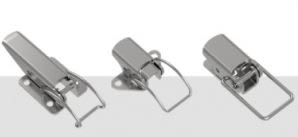Dillinpolish
Mechanical
- Mar 30, 2020
- 4
I've been designing a spring form for an over-center latch.

Because the spring form is an abnormal shape, I've been using ANSYS to calculate the stresses and stay below the material yield strength I've found online (<78% tensile yield as a design criteria).
The music wire I'm using is 2 mm A228. Does anyone know the ultimate tensile strength for this material? I'm seeing this over-center latch fail in fatigue (I think there is an alternating load I'm not accounting for that is creating this failure) and I'd like to run some high-cycle fatigue calculations, but estimating the ultimate strength throws this calculation off.
Anything helps.
Thanks!

Because the spring form is an abnormal shape, I've been using ANSYS to calculate the stresses and stay below the material yield strength I've found online (<78% tensile yield as a design criteria).
The music wire I'm using is 2 mm A228. Does anyone know the ultimate tensile strength for this material? I'm seeing this over-center latch fail in fatigue (I think there is an alternating load I'm not accounting for that is creating this failure) and I'd like to run some high-cycle fatigue calculations, but estimating the ultimate strength throws this calculation off.
Anything helps.
Thanks!
